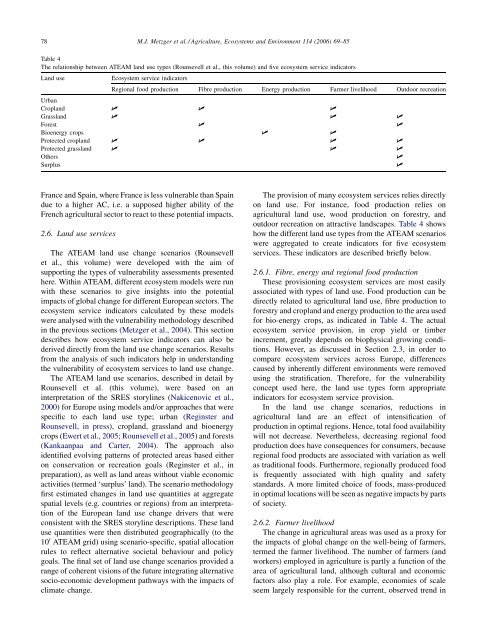The vulnerability of ecosystem services to land use change
The vulnerability of ecosystem services to land use change
The vulnerability of ecosystem services to land use change
Create successful ePaper yourself
Turn your PDF publications into a flip-book with our unique Google optimized e-Paper software.
78<br />
M.J. Metzger et al. / Agriculture, Ecosystems and Environment 114 (2006) 69–85<br />
Table 4<br />
<strong>The</strong> relationship between ATEAM <strong>land</strong> <strong>use</strong> types (Rounsevell et al., this volume) and five <strong>ecosystem</strong> service indica<strong>to</strong>rs<br />
Land <strong>use</strong><br />
Ecosystem service indica<strong>to</strong>rs<br />
Regional food production Fibre production Energy production Farmer livelihood Outdoor recreation<br />
Urban<br />
Crop<strong>land</strong> U U U<br />
Grass<strong>land</strong> U U U<br />
Forest U U<br />
Bioenergy crops U U<br />
Protected crop<strong>land</strong> U U U U<br />
Protected grass<strong>land</strong> U U U<br />
Others<br />
U<br />
Surplus<br />
U<br />
France and Spain, where France is less vulnerable than Spain<br />
due <strong>to</strong> a higher AC, i.e. a supposed higher ability <strong>of</strong> the<br />
French agricultural sec<strong>to</strong>r <strong>to</strong> react <strong>to</strong> these potential impacts.<br />
2.6. Land <strong>use</strong> <strong>services</strong><br />
<strong>The</strong> ATEAM <strong>land</strong> <strong>use</strong> <strong>change</strong> scenarios (Rounsevell<br />
et al., this volume) were developed with the aim <strong>of</strong><br />
supporting the types <strong>of</strong> <strong>vulnerability</strong> assessments presented<br />
here. Within ATEAM, different <strong>ecosystem</strong> models were run<br />
with these scenarios <strong>to</strong> give insights in<strong>to</strong> the potential<br />
impacts <strong>of</strong> global <strong>change</strong> for different European sec<strong>to</strong>rs. <strong>The</strong><br />
<strong>ecosystem</strong> service indica<strong>to</strong>rs calculated by these models<br />
were analysed with the <strong>vulnerability</strong> methodology described<br />
in the previous sections (Metzger et al., 2004). This section<br />
describes how <strong>ecosystem</strong> service indica<strong>to</strong>rs can also be<br />
derived directly from the <strong>land</strong> <strong>use</strong> <strong>change</strong> scenarios. Results<br />
from the analysis <strong>of</strong> such indica<strong>to</strong>rs help in understanding<br />
the <strong>vulnerability</strong> <strong>of</strong> <strong>ecosystem</strong> <strong>services</strong> <strong>to</strong> <strong>land</strong> <strong>use</strong> <strong>change</strong>.<br />
<strong>The</strong> ATEAM <strong>land</strong> <strong>use</strong> scenarios, described in detail by<br />
Rounsevell et al. (this volume), were based on an<br />
interpretation <strong>of</strong> the SRES s<strong>to</strong>rylines (Nakicenovic et al.,<br />
2000) for Europe using models and/or approaches that were<br />
specific <strong>to</strong> each <strong>land</strong> <strong>use</strong> type; urban (Reginster and<br />
Rounsevell, in press), crop<strong>land</strong>, grass<strong>land</strong> and bioenergy<br />
crops (Ewert et al., 2005; Rounsevell et al., 2005) and forests<br />
(Kankaanpaa and Carter, 2004). <strong>The</strong> approach also<br />
identified evolving patterns <strong>of</strong> protected areas based either<br />
on conservation or recreation goals (Reginster et al., in<br />
preparation), as well as <strong>land</strong> areas without viable economic<br />
activities (termed ‘surplus’ <strong>land</strong>). <strong>The</strong> scenario methodology<br />
first estimated <strong>change</strong>s in <strong>land</strong> <strong>use</strong> quantities at aggregate<br />
spatial levels (e.g. countries or regions) from an interpretation<br />
<strong>of</strong> the European <strong>land</strong> <strong>use</strong> <strong>change</strong> drivers that were<br />
consistent with the SRES s<strong>to</strong>ryline descriptions. <strong>The</strong>se <strong>land</strong><br />
<strong>use</strong> quantities were then distributed geographically (<strong>to</strong> the<br />
10 0 ATEAM grid) using scenario-specific, spatial allocation<br />
rules <strong>to</strong> reflect alternative societal behaviour and policy<br />
goals. <strong>The</strong> final set <strong>of</strong> <strong>land</strong> <strong>use</strong> <strong>change</strong> scenarios provided a<br />
range <strong>of</strong> coherent visions <strong>of</strong> the future integrating alternative<br />
socio-economic development pathways with the impacts <strong>of</strong><br />
climate <strong>change</strong>.<br />
<strong>The</strong> provision <strong>of</strong> many <strong>ecosystem</strong> <strong>services</strong> relies directly<br />
on <strong>land</strong> <strong>use</strong>. For instance, food production relies on<br />
agricultural <strong>land</strong> <strong>use</strong>, wood production on forestry, and<br />
outdoor recreation on attractive <strong>land</strong>scapes. Table 4 shows<br />
how the different <strong>land</strong> <strong>use</strong> types from the ATEAM scenarios<br />
were aggregated <strong>to</strong> create indica<strong>to</strong>rs for five <strong>ecosystem</strong><br />
<strong>services</strong>. <strong>The</strong>se indica<strong>to</strong>rs are described briefly below.<br />
2.6.1. Fibre, energy and regional food production<br />
<strong>The</strong>se provisioning <strong>ecosystem</strong> <strong>services</strong> are most easily<br />
associated with types <strong>of</strong> <strong>land</strong> <strong>use</strong>. Food production can be<br />
directly related <strong>to</strong> agricultural <strong>land</strong> <strong>use</strong>, fibre production <strong>to</strong><br />
forestry and crop<strong>land</strong> and energy production <strong>to</strong> the area <strong>use</strong>d<br />
for bio-energy crops, as indicated in Table 4. <strong>The</strong> actual<br />
<strong>ecosystem</strong> service provision, in crop yield or timber<br />
increment, greatly depends on biophysical growing conditions.<br />
However, as discussed in Section 2.3, in order <strong>to</strong><br />
compare <strong>ecosystem</strong> <strong>services</strong> across Europe, differences<br />
ca<strong>use</strong>d by inherently different environments were removed<br />
using the stratification. <strong>The</strong>refore, for the <strong>vulnerability</strong><br />
concept <strong>use</strong>d here, the <strong>land</strong> <strong>use</strong> types form appropriate<br />
indica<strong>to</strong>rs for <strong>ecosystem</strong> service provision.<br />
In the <strong>land</strong> <strong>use</strong> <strong>change</strong> scenarios, reductions in<br />
agricultural <strong>land</strong> are an effect <strong>of</strong> intensification <strong>of</strong><br />
production in optimal regions. Hence, <strong>to</strong>tal food availability<br />
will not decrease. Nevertheless, decreasing regional food<br />
production does have consequences for consumers, beca<strong>use</strong><br />
regional food products are associated with variation as well<br />
as traditional foods. Furthermore, regionally produced food<br />
is frequently associated with high quality and safety<br />
standards. A more limited choice <strong>of</strong> foods, mass-produced<br />
in optimal locations will be seen as negative impacts by parts<br />
<strong>of</strong> society.<br />
2.6.2. Farmer livelihood<br />
<strong>The</strong> <strong>change</strong> in agricultural areas was <strong>use</strong>d as a proxy for<br />
the impacts <strong>of</strong> global <strong>change</strong> on the well-being <strong>of</strong> farmers,<br />
termed the farmer livelihood. <strong>The</strong> number <strong>of</strong> farmers (and<br />
workers) employed in agriculture is partly a function <strong>of</strong> the<br />
area <strong>of</strong> agricultural <strong>land</strong>, although cultural and economic<br />
fac<strong>to</strong>rs also play a role. For example, economies <strong>of</strong> scale<br />
seem largely responsible for the current, observed trend in
















